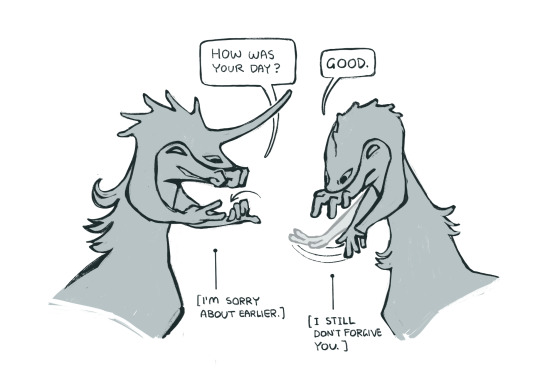#also I think this is my 100th ask? wrow 🎉
Note
do you have any ideas about Knight language(s)? How they sound, work, etc.?
I'm glad you asked! Sorry this took so long; it's a bit of a long one.
For Knight languages, all vocalisations originate from the Host. Spoken language is harsh and guttural, consisting of deep growling, hissing, and ‘rolls of the tongue’. Their growls are quite loud, and accompanying them are low-frequency vibrations which can be felt across the entire body. The closest approximation would be cassowary rumbling. Hosts rely less on their ears (which are small holes hidden under their fur) and more on vibrations to detect sound.
Helmets are incapable of making such complex vocalisations and instead use many forms of sign language to communicate via their manipulators. When a Knight mentally separates their Host and Helmet, the Helmet is no longer able to speak through the Host. As such, there are two main language forms used by Knights of every regional variety; the vocal Host language and the signing Helmet language.
However, typically when Knights are communicating, they may use a mixture of the two, called Speech-sign. Helmet signing accompanied by Host speech aids in conveying proper tone, considering Host articulation tends to be very monotone. It also contains underlying messages; or what we would call subtext. As a result, Knights tend to be highly attentive to body language and focus on hand movements rather than eyes/mouth when in conversation.

[Pictured above: the Plains pike-fort Kryyit-kan conversing with their guard-spire mate, Ynsi-jehwa. Kryyit is apologising for squishing Ynsi's favourite pet bug.]
There are some ‘universal’ signs and gestures which are generally understood by all Knights, no matter the language or region. Many of these signs are also used during hunts to communicate from afar without startling prey. Mountain, Plains, and Polar Knight children are taught these from an early age.

[Pictured above: the eight essential signs used by all Knights. Helmet manipulators are highly dexterous and can move in various directions.]
Knights also have ‘drumming’ languages, which is a method of communicating over long distances. Mainly used in Plains regions, Knights drum on the sand with their back feet in patterns not unlike Morse code. For more reliable and accurate communication they may use a thumping device. Knights are able to detect these seismic disturbances over vast stretches of land.
ADDITIONAL FACTS
Mountain Knight names tend to contain a lot of consonants and are the most hissy/raspy/guttural. The Host name comes before the Helmet name, and they are combined into one. (Eg. Neghasharat-Hksuutaka = Negha-taka)
Plains Knight names have more vowels and are slightly higher pitched. They are similar to the Mountain naming scheme, except the Helmet name comes before the Host name. (Eg. Krryitmana-Kankala = Krryit-kan)
Polar Knight names are not two-part. They do not name their Host or Helmets at all, only naming the Knight infant when they are assimilated. They are generally shorter and are the highest pitched. (Eg. Reio)
Knight 'laughing' sounds exactly like tiger chuffing!
#thank you for the ask!!#had a lot of fun with this one#vivere 44#knights#ask#aliens#speculative biology#spec bio#speculative evolution#spec evo#worldbuilding#art#my art#also I think this is my 100th ask? wrow 🎉#I haven't yet figured out what their written language looks like. that's for another time
229 notes
·
View notes